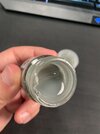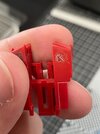Lepper
New Member
- Joined
- Sep 6, 2013
- Messages
- 5
Long-time lurker, first-time poster.
While searching for a readily available (read: from Canadian Tire) putty/epoxy that works with styrene, I came across an astonishing suggestion: melt styrofoam in acetone. I hadn't realized it before, but styrofoam is just and expanded version of the stryrene plastic we're all so familiar with. So, the process, such as it is, is identical to this video from ModelManTom:
ToolTip: Melting Styrene 1
I'd just bought some new furniture, which was conveniently packed in blocks of styrofoam, so I thought I'd give it a shot. Unlike in ModelManTom's video, you don't have to wait 24h; the styrofoam melts almost immediately to produce the snot-like "putty" shown. It spreads pretty easily, too. Quick tip: the thinner you spread it, the faster it drys. Because it's exactly the same stuff as in your model, it sands exactly the same. Consequently, even severe sinks or cracks can be filled and sanded very smooth.
Give it a try!
While searching for a readily available (read: from Canadian Tire) putty/epoxy that works with styrene, I came across an astonishing suggestion: melt styrofoam in acetone. I hadn't realized it before, but styrofoam is just and expanded version of the stryrene plastic we're all so familiar with. So, the process, such as it is, is identical to this video from ModelManTom:
ToolTip: Melting Styrene 1
I'd just bought some new furniture, which was conveniently packed in blocks of styrofoam, so I thought I'd give it a shot. Unlike in ModelManTom's video, you don't have to wait 24h; the styrofoam melts almost immediately to produce the snot-like "putty" shown. It spreads pretty easily, too. Quick tip: the thinner you spread it, the faster it drys. Because it's exactly the same stuff as in your model, it sands exactly the same. Consequently, even severe sinks or cracks can be filled and sanded very smooth.
Give it a try!



